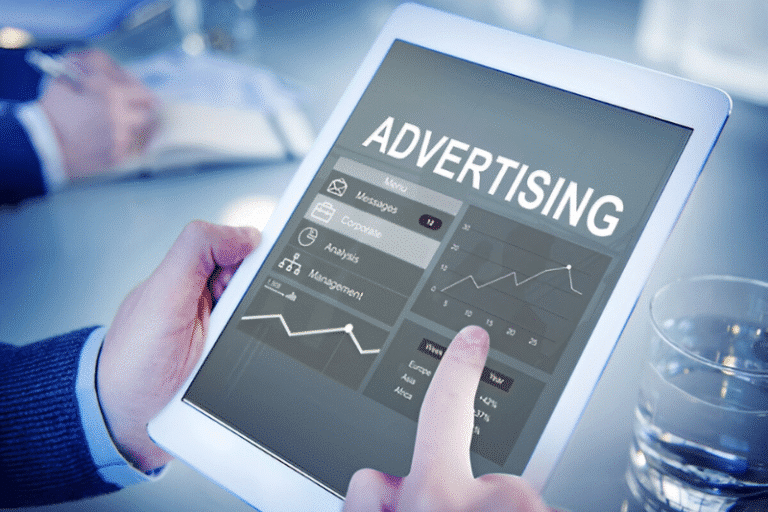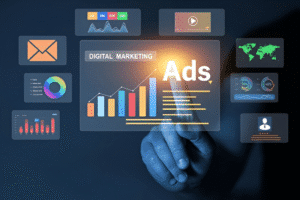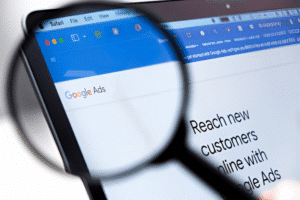Discover paid media strategies for 2026 and learn when and how to optimize your ad campaigns from audience and creative tweaks to budget shifts, A/B testing, and conversion tracking.
Optimizing Paid Advertising Campaigns – Key Takeaways
When I first started working in paid advertising and optimizing paid advertising campaigns, I soon discovered that the foundation of any successful campaign is the establishment of specific, quantifiable goals. My campaigns started with nebulous goals like “increase sales” or “boost brand awareness.” However, I soon found that it was very difficult to determine success in the absence of clear goals. In one campaign, I recall merely trying to “get more clicks”. Therefore, I’ve prepared a series of media-buying blog posts to highlight one of the crucial steps of optimizing paid advertising campaigns in terms of measuring, reporting, and optimizing.
- Setting clear and measurable goals is essential for the success of your paid advertising campaigns.
- Choosing the right key performance indicators (KPIs) will help you track the effectiveness of your campaigns.
- Tracking and analyzing data regularly will provide valuable insights for optimizing your advertising strategies.
- A/B testing and experimentation can help you identify the most effective ad variations for your target audience.
- Proper budget allocation and optimization are crucial for maximizing the impact of your paid advertising efforts.
Optimizing Paid Advertising Campaigns – Measuring and Reporting KPIs
I had many clicks but no real sales after a month of running ads. It was an awakening experience that made me realize how crucial it is to set clear, measurable goals. My first step now is to ask myself what I hope to accomplish. I can make a plan for my campaigns by establishing SMART goals, which stand for Specific, Measurable, Achievable, Relevant, and Time-bound.
These goals could be a target return on ad spend (ROAS), a certain number of leads, or a percentage increase in sales. Instead of stating, “I want to increase website traffic,” for example, I might state, “increase website traffic by 30 percent over the next three months.”I can effectively focus my efforts and gauge my progress thanks to this clarity.
1. Setting Clear and Measurable Goals
Choosing the appropriate Key Performance Indicators (KPIs) to monitor comes next after I have established my objectives. In the beginning, I frequently felt overpowered by the abundance of metrics at my disposal. It took some trial and error to realize that not all KPIs are made equal; they must be in line with my particular objectives.
2. Choosing the Right Key Performance Indicators (KPIs)
Should I concentrate on cost per acquisition (CPA), conversion rates, or click-through rates (CTR)? For instance, I gave metrics like lead conversion rate and cost per lead top priority when I started a campaign to generate leads for a webinar. For an e-commerce campaign, however, I turned my attention to metrics like return on ad spend and average order value.
I can evaluate the success of my campaigns more accurately and make wise decisions going forward if I choose KPIs that closely match my goals. The secret to successful paid advertising is tracking and analyzing data. Because I initially believed that running advertisements was sufficient, I would frequently ignore this important step.
3. Tracking and Analyzing Data Impressions, Clicks, Conversions
However, the more I explored the role of marketing data analytics while working hands-on with Google Analytics and Facebook Ads Manager, the more I found a wealth of information that could greatly influence my campaigns. I remember clearly a campaign where I saw that my landing page had an abnormally high bounce rate.
4. A/B Testing and Experimentation
I discovered that the page wasn’t mobile-friendly after delving into the data. With this knowledge in hand, I made changes to enhance the user experience, which eventually resulted in a notable decrease in bounce rates and a rise in conversions. I learned from this experience that data is more than just numbers; it also conveys a narrative about what is and is not working.
Frequent data analysis enables me to make data-driven decisions that improve campaign performance and quickly pivot. A/B testing has emerged as one of my preferred methods for paid advertising campaign optimization.
5. Ad, Landing Page, and Audience Targeting Variations
I was afraid that altering just one component would cause my entire campaign to fail, so I was first reluctant to try new things. However, I was astounded by the outcomes of my first A/B test on ad copy. Just changing the headline from “Get Your Free Trial” to “Unlock Your Free Trial Today,” I noticed a discernible rise in click-through rates.
Nowadays, a key component of my campaign strategy is A/B testing. Every experiment, whether it’s experimenting with different headlines, images, or calls to action, gives me important information about what appeals to my audience. Two distinct holiday sale ad creatives were used in one noteworthy test; one had a festive theme, while the other was more understated.
The festive advertisement performed an astounding 40% better than the minimalist one. This event reaffirmed the value of trying new things to find out what interests potential clients.
6. Budget Allocation and Optimization
Allocating funds can frequently feel like walking a tightrope; too much concentration in one area can result in wasteful spending, while too little concentration can impede development. I used intuition rather than data-driven insights when allocating budgets for my early campaigns. As a result, high-performing advertisements frequently suffered from a lack of funding, while underperforming ones frequently received more than they were due.
7. Ad Spend, Return on Investment, Cost Per Conversion
I’ve come to realize that budget allocation requires a more strategic approach over time. I’ve been able to greatly increase ROI by consistently tracking performance indicators and redistributing funds to campaigns that are performing well. In a recent campaign for the launch of a new product, for example, I observed that one set of ads was routinely outperforming others in terms of conversions.
8. Ad Creative and Copy Optimization
I was able to build upon the success of that mid-campaign ad and increase sales by allocating a larger portion of the budget to it. I find both excitement and challenge in the creative side of paid advertising. To stand out in a crowded market, you must create eye-catching ad copy and images.
I used generic templates and competitor ideas a lot in the beginning, which resulted in uninspired advertisements that didn’t connect with my target audience. I’ve written another blog post about advanced custom audience profiling to increase your user acquisition (UA) efforts. Explore more.
9. Ad Engagement, Ad Relevance, and Ad Messaging
Through experience, I’ve learned how crucial uniqueness and genuineness are in advertising creativity. Making a series of humorous advertisements that lightheartedly highlighted the special qualities of our product was one campaign that stood out. The reaction was overwhelmingly positive.
In addition to seeing a sharp increase in engagement rates, we also got a ton of comments complimenting our inventiveness. I learned from this experience that spending time creating original ad creatives. It can greatly improve brand perception and produce better outcomes. The icing on the cake for any successful paid advertising campaign is conversion rate optimization, or CRO.
10. Conversion Rate Optimization, Landing Page Experience, and Call-to-Action Effectiveness
Making sure that visitors become customers is essential after all the work I put into getting them to visit my website. When I first started, I frequently ignored this factor. Because I thought that if people clicked on my advertisements, they would inevitably buy something.
However, after looking at how users interacted with my landing pages. I saw that a number of things were standing in the way of conversions, including long forms and ambiguous calls to action. Conversion rates increased dramatically when I made the user experience simpler and made it easier for visitors to take action.
Optimizing Paid Advertising Campaigns – Popular FAQs
What are the essential strategies for measuring, reporting, and optimizing paid advertising campaigns?
The essential strategies for measuring, reporting, and optimizing paid advertising campaigns include:
- Setting clear and measurable goals.
- Choosing the right key performance indicators (KPIs).
- Tracking and analyzing data.
- A/B testing and experimentation.
- Budget allocation and optimization.
- Ad creative and copy optimization.
- Conversion rate optimization.
Why is it important to set clear and measurable goals for paid advertising campaigns?
Setting clear and measurable goals for paid advertising campaigns is important. It provides a benchmark for success, helps in evaluating the effectiveness of the campaigns, and guides the optimization process.
How do you choose the right key performance indicators (KPIs) for paid advertising campaigns?
Choosing the right key performance indicators (KPIs) for paid advertising campaigns involves aligning the KPIs with the campaign goals. Particularly focusing on metrics that directly impact the business objectives, and selecting KPIs that are measurable and actionable.
What is the importance of tracking and analyzing data in paid advertising campaigns?
Tracking and analyzing data in paid advertising campaigns is important. Because it provides insights into the performance of the campaigns, it helps in identifying areas for improvement. It also enables data-driven decision-making.
What is A/B testing, and why is it important in paid advertising campaigns?
A/B testing is a method of comparing two versions of an ad or landing page. To determine which one performs better. It is important in paid advertising campaigns because it helps in optimizing ad elements for better performance. As well as improving the overall campaign effectiveness.
How can budget allocation and optimization impact the success of paid advertising campaigns?
Budget allocation and optimization can impact the success of paid advertising campaigns. By ensuring that resources are allocated to the most effective channels and tactics. Furthermore, maximizing the return on investment and optimizing the overall campaign performance.
What is ad creative and copy optimization play a vital role in paid advertising campaigns?
Both ad creative and copy optimization involve refining the visual and textual elements of ads. Not only do they improve their effectiveness in capturing the audience’s attention, but they also convey the message and drive desired actions.
What is conversion rate optimization, and what is its significance in paid advertising campaigns?
Conversion rate optimization (CRO) involves improving the percentage of website visitors who take a desired action. Additionally, it’s one of the crucial factors as it directly impacts the campaign’s ROI and overall effectiveness.
What’s the first step to optimizing a paid ad campaign performance?
Define clear goals (ROAS, CPA, conversions), map them to metrics, and establish a baseline before testing changes.
How should I set a realistic budget for optimization?
Start with a conservative test budget, allocate separate budgets per channel, and adjust based on incremental ROAS and statistical significance of results.
Which bidding strategy should I choose to start?
Start with automated bidding aligned to your goal (e.g., maximize conversions or target CPA/ROAS). Switch to manual if you need tighter control after data accrues.
How often should I review campaign performance?
Daily for spending and immediate issues; weekly for insights and optimization; monthly for strategic pivots.
What is “ad fatigue” and how can I prevent it?
Ad fatigue happens when the audience ignores or hates your ads due to repetition. Rotate creatives, refresh visuals, update copy, and test new formats.
How do I properly use A/B testing in paid ads?
Test one variable at a time (headlines, images, CTAs, landing pages), run statistically significant trials, and implement winning variants across the account.
What are the best practices for negative keywords?
Regularly prune irrelevant terms, add high-CPC terms with low convertibility as negatives, and use search term reports to refine.
How can I improve targeting without blowing up spend?
Layer audiences (demographics, intents, affinities), use lookalike/audience expansion cautiously, and exclude low-value segments.
What role do landing pages play in campaign optimization?
They determine post-click conversion; ensure fast load times, clear value proposition, aligned messaging, and simple conversion paths.
How should I track and measure success across channels?
Implement consistent UTMs, use a single attribution window, prefer ROAS/CPA as primary metrics, and visualize data in a unified dashboard.
When should I pivot away from underperforming campaigns?
If there’s no statistically significant improvement after multiple test cycles, and the budget is not delivering incremental value over a reasonable horizon.
What is frequency capping, and why does it matter?
Frequency capping limits how often a user sees an ad; it reduces waste, ad fatigue, and improves engagement and efficiency.
How can I optimize creatives for performance?
Align creatives to offer, use strong, contrasty visuals, test numbers vs. benefits, and include a clear, compelling CTA.
Should I use remarketing, and how aggressively?
Yes. Remarketing often yields high ROI; segment by actions (viewed product, added to cart, past purchasers) and tailor messages accordingly.
What automation tools or features should I leverage?
Automated rules (budgets, pausing underperformers), automated bidding, audience segmentation, and feed-based ads for dynamic creative optimization.
Optimizing Paid Advertising Campaigns – The Next Steps
The significance of consistently optimizing for conversions as part of my overall advertising strategy was highlighted by one specific change. That is particularly involved in cutting the number of fields in our sign-up form from five to three. This seemingly insignificant change resulted in a twenty-five percent sudden increase in sign-ups.
In summary, tracking, evaluating, and refining paid advertising campaigns is a continuous process that offers numerous growth opportunities. Employing these ten crucial tactics clearly defines objectives, selects appropriate KPIs, and closely monitors data. As well as adopting A/B testing, prudently allocating budgets, improving ad creatives, and concentrating on conversion rates. GDP has been able to successfully traverse this challenging terrain. We learn something new from every campaign, which makes this line of work both demanding and fulfilling.
Concerned about your digital marketing efforts and paid advertising results? Book a strategy call to boost your paid ads reach and conversion.






